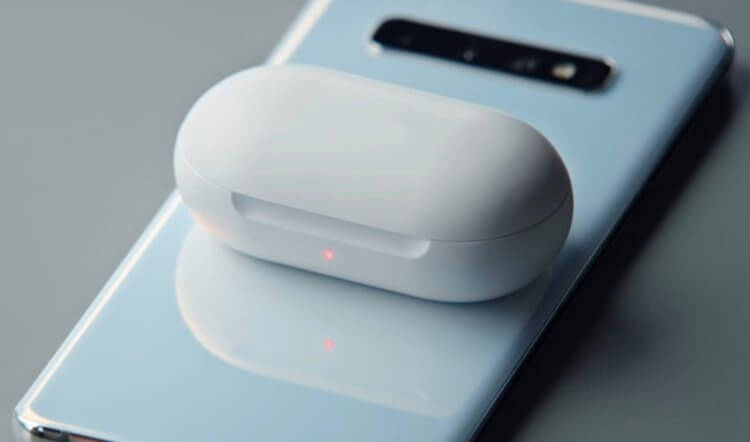Some time ago, when the world only saw reverse charging, I said that it has no prospects and is only needed to sell the smartphone in which it is installed. Advertisements have shown that the solution allows other smartphones to be charged. I tried it, but predictably charging was sooooo slow. At the same time, when charging, both smartphones were very hot and the “donor” was discharged very quickly. I ran into a situation the other day where I changed my mind about this feature. She made me not only think about it, but also want a smartphone with reversible charging, which are now almost not on the market.

Reverse charging can work like this, but there are other options.
What is Reverse or Reverse Charging
Not so long ago, a function began to be introduced in the smartphone industry, which still seems unnecessary to many. I'm talking about wireless charging. Previously, I treated it calmly and used it only occasionally, but now I almost always keep my smartphone at the charging station and just forgot about what a discharged battery is. You don't have to do anything special, but the effect is there. Yes, the charging speed in this case turns out to be lower, but it is used more for maintenance rather than fast charging. About which you can talk separately.
Reversible wireless charging is based on conventional wireless charging. It's just that the coil inside the smartphone can both “receive” the field and create it. Considering this is a smartphone and not an electrical outlet, the charging speed is predictably very slow due to the low power. This is what initially scared me off when I thought about this function.
When I changed my mind about reversible wireless charging
I am currently using a bunch of two phones, one of which is iPhone 11 Pro. I use it for listening to music and podcasts. To this I have AirPods Pro headphones with a wireless charging case. So I ended up in a situation where my headphones sat down, but I still wanted a little music.
From the socket, the headphones are charged for several hours of listening in a couple of tens of minutes. But I didn't have an outlet. At the same time, I was sitting at the table and could easily lay out my smartphone and headphones.

So it's quite convenient to charge headphones on the go
In this situation, I realized that there is still a point in reverse charging. True, it rather acts as insurance. This function takes up almost no space inside the case, does not affect the weight and does not spoil the appearance. But in an emergency it can help to charge something small.
Occasionally it can even be used to charge another smartphone, but my experience has shown that this is still a trick. Then I charged iPhone X from Huawei P30 Pro and in 30 minutes of charging only a couple of percent of the battery was added. The situation was complicated by the fact that I was driving in a car and could not place my smartphone strictly one above the other.
Perhaps it would be better if the smartphones lay flat on the table, but no. Later, I conducted an experiment and realized that the charging speed did not change much, but subjectively, they warmed up less. And yes, of course, smartphones were without covers, so that nothing would affect the charging speed.
Can I use wireless charging
Many people do not use wireless charging due to the fact that they worry about the battery of their smartphone. On the one hand, the fears are justified, because the temperature with this method of energy transfer is higher. Anyway, there is some kind of incomprehensible magic that many are afraid of.
It should be understood that you can ruin your smartphone with a bad cable, a non-original power supply or an external battery. Sometimes even a good PowerBank can burn up the power controller in a smartphone or simply damage the battery. When transmitting through a cable, there are a lot of things that can cause increased risks from a voltage surge on the power supply to a short circuit when moisture enters the connector. I already talked about how users kill their smartphones themselves, and this is there too.
In this case, wireless charging is essentially the most gentle way to transfer energy. Let it not charge the smartphone in 30-40 minutes.

It is very convenient to charge your smartphone wirelessly.
In what situations is wireless charging convenient?
Even if we constantly use a smartphone, nothing prevents us from putting it not just on the table, but on a special platform in between. I always knew I used it a lot, but underestimated how long it lay on the table until I started using wireless charging.
As a result, I put one at home and one at work and always hit the road with 90-100 percent charge. I haven't used the cable for several weeks.
I find the charging of the vertical type especially convenient. Modern smartphones, in the shelf of which we are waiting for the addition, have a face unlock function. When a message arrives, the screen turns on, you look at it and the message itself is displayed on the screen. You can set up unlocking to open the home screen. In this case, the smartphone turns on and you can immediately answer. One way or another, but the smartphone will not need to be picked up to receive information from the notification.
All this makes wireless charging a really convenient way to fill your gadget with energy. And now I understand what reverse charging is for and will treat it more respectfully.
What do you think about conventional wireless charging and reversible charging? Are they in your smartphones and how often do you use them? Share your opinion in the comments or our Telegram chat.
